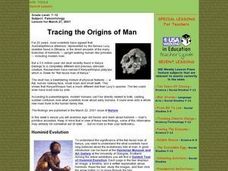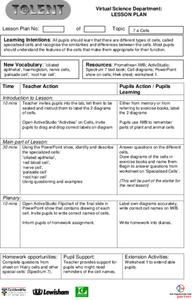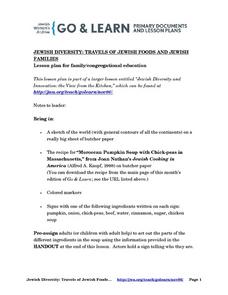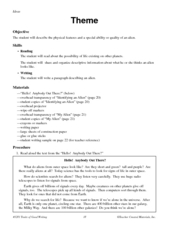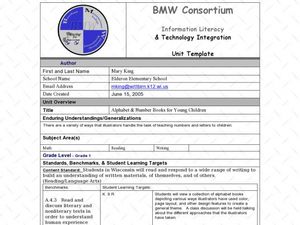Curated OER
Insect Anatomy
Young scholars explore the anatomy of an insect. In this activity the characteristics of insects, students explore parts of an insect. Young scholars gain knowledge through pictures and charts showing insects and their body parts....
Curated OER
Tooling Around Arizona: Reading Arizona Maps
Students research Arizona maps. In this map lesson, students discuss map titles, scales, directions, elevation, and symbols. The class will examine topography, landforms, and rivers found on an Arizona map.
Curated OER
Planet Discovery and Identification
Students explore the internet world of Second Life and create a portfolio about the planets in our solar system. In this planets lesson plan, students provide many facts about 1 specific planet.
Curated OER
Reading in Preschool
Students read along with their parents to promote their own reading and fluency. In this reading lesson plan, students look at picture books and follow along with their finger.
Curated OER
Frogs Frogs Frogs
Young scholars view a disk on the continental movement and analyze the given data on fossils, rock types and climate zones. In this geology lesson plan students draw a diagram of the earths layers, take a quiz complete a PowerPoint...
Curated OER
Space, the Final Frontier...
Students study a common theory on how the solar system was formed and examine the relative scale of the size and distances among the bodies of the Solar System.
Curated OER
Tracing the Origins of Man
Students discuss Hominid evolution through various websites and other resources. They examine online fossil skulls, discuss the use of tools by ancient man, and look for examples of sophisticated tools built by man.
Curated OER
Vertebrates
Fifth graders examine the traits and characteristics of vertebrates. Identifying the key factors that make the classes of vertebrates unique, they create a children's book. They decide which material is necessary to share about the...
Curated OER
Cells
Learners explore the types of cells and their appropriate function. After observing a PowerPoint presentation, students draw diagrams of cells. Using a specified website, learners identify parts of plant and animal cells. They answer...
Curated OER
Exemplary Plans, Engineer It!
Students research tall buildings and identify the geometric shapes used in the construction of the buildings. They compare shapes and infer why some are better than others in building. They produce a multimedia presentation of geometric...
Curated OER
Blend-A-Plant Levels of Organization
Students' identify and analyze the levels of organization and the emergent properties through experimentation. Students' apply the differences in the properties of a plant before and after it has been subjected to a kitchen blender.
Curated OER
"Wheels, Wings and Other Things"
Learners participate in various reading and writing activities related to the book "Wheels, Wings and Other Things" by Monica Hughes and Barbara Hunter. They participate in a shared reading activity, and write a new page for a book...
Curated OER
Jewish Diversity: Travels of Jewish Foods and Jewish Families
Pupils are introduced to Jewish history thorugh food and various ingredients. As a class, they read a passage from the Bible about the exodus from Egypt and answer discussion questions. They make traditional Jewish meals with their...
Curated OER
Famous People of the Gold Rush
Fourth graders research a famous person from the Gold Rush era. Using the Internet, they take notes from creditable websites and write their rough drafts of their paper. They use peer editing to check for spelling and grammar errors. ...
Curated OER
Wall of Philanthropists: King Day (7th)
Students recognize the importance of justice, tolerance, equality, and historical figures. In this philanthropic actions lesson, students study the philanthropic actions of historical figures, and learn about the concepts of fairness,...
Curated OER
Theme
Students examine a reading selection. In this descriptive writing lesson, students read an excerpt from "Hello! Anybody Out There?". Students discuss the idea of aliens living on other planets, describe what they think an alien looks...
Curated OER
Photo Editing and Photo Ethics
students investigate how to editphotos and understand the ethics of photo-editing in regard to photo-journalism. In this photo journalism lesson, students examine photos and photo spreads in various sources to identify editing components...
Curated OER
Alphabet & Number Books for Young Children
First graders create either an alphabet or number book using Kid Pix software. In this alphabet and/or number unit, 1st graders design a themed alphabet and/or number book using the Kid Pix software over the course of three weeks....
Curated OER
Read a Transportation Story
Third graders research the building of a transcontinental road. In this railroad history lesson, 3rd graders discuss past and present transportation. Students look at historical photos and compare and contrast photos from today.
Curated OER
Three Part Dialogue
Eighth graders write a three part dialogue as part of an effective memoir. In this three part dialogue lesson, 8th graders are given two parts of a dialogue and emotions that accompany the words. Students then create the third part of...
Curated OER
Diversity of Life
Pupils identify the difference between eukaryote and prokaryotes and examine the structure of bacteria. In this bacteria lesson students examine the different ways that bacteria are classified through an activity.
Curated OER
Ad Awareness from Admongo.gov
Students explore mass media by completing worksheets in class. In this consumerism activity, students discuss the meaning behind advertisements and how they are used in television, the Internet and print. Students analyze a group of ads...
Curated OER
I, Spy
Fifth graders utilize the library in order to find the answers to three questions about The Revolutionary War. In this writing and library skills activity, 5th graders pretend they are a Spy, and write the answers in a fictional letter...
Curated OER
Give me Food!
Young scholars study the food guide pyramid and use it to create their own eating program.In this health lesson students visit websites to calculate their BMR, activity level and weight then create a nutrition plan








